

South Africa
Southern Africa
UK
Campsites (Africa)
We'd read about this route in a magazine and it was one of the reasons that we decided to explore the Eastern Cape. Baviaanskloof means 'Valley of the Baboons' and we certainly saw several troops of them. The Western part of the Kloof can be accessed by any vehicle but for the Wilderness Area and the 3 mountain passes in the Eastern section you have to have a 4x4 vehicle. Between Graaff-Reinet and Willowmore we had a puncture, caused by a large stone (one of the disadvantages of driving on gravel roads) so had to change a wheel. Fortunately the next village we traveled through had a garage with a workshop so they were able to repair the tyre for us. We stopped at a farm just outside the' Valley' for a couple of nights. The second evening there was a thunderstorm, although fortunately we just caught the edge if it. We were able to move the braai next to the awning so that we could keep dry while it rained for an hour or so. Later there was a superb double rainbow. We entered the Baviaanskloof via a narrow gorge with rocky outcrops all around. We could tell from the amount of water in the streams crossing the road that there had been a lot more rain overnight that we'd had as mud had been washed across the road where the streams had overflowed the 'bridges'. Once through the gorge the valley opened up and there were several farms, many of them offering accommodation. The landscape was certainly greener that we'd seen for quite a while. At one point we came across this tortoise making its way down the side of the road. At Geelhoutbos we entered the Baviaanskloof Nature Reserve (only 4x4 vehicles are allowed past this point) and were back into a much narrowed valley with the track meandering around the contours and then up over the Grassnek Pass where there were a few rocky, steep sections. We'd booked a site at the Doodsklip campsite in the Reserve (6 sites with no facilities apart from a couple of 'long-drop' toilets) There was however a beautiful dam and we were soon cooling off in the water. We stayed at the site for a couple of nights. Almost as soon as we arrived we saw baboons nearby so were careful not to leave out anything that they might pinch, however we came back from a drive on the second day to find that they'd ripped open our bag of charcoal and the firelighters box and spread the contents around. We saw several buck while we were at the campsite, amongst the trees or down by the dam. The next day saw us on our way, tackling the last 2 passes in the Kloof. For the first time this trip it was raining in the morning so we packed up and were away in record time! After crossing some streams in the valley we came to the Holgat Pass which was certainly the trickiest of the passes with some very uneven, rocky sections and long, long drops down into the valley. Once on the plateau at the top we stopped to look at a cableway, built by a local farmer in 1965 from the top of the Pass to his farm across the gorge. Before this was built it took half a day to reach the farm. Soon after we took this photo the clouds rolled in again and we couldn't see much at all. Plenty of wild flowers on the plateau and in particular a variety of proteas, several of which were in flower. Because of the rain the muddy road on the plateau was very slippery and at one point the truck did a 90 degree slide on a perfectly straight road. When we got out to investigate we discovered that the tyres were completely covered in red mud with no tread showing. Luckily we were soon onto a rockier section so lost the mud. Combrink's Pass took us back down into the valley, a long rocky pass but not as difficult as the previous one. It took us 1 3/4 hours to cover the 19km from the campsite to the start of the 'proper' gravel road. The road then followed the river which we must have crossed a dozen times. There was obviously water in this river all year round as the vegetation was very dense, almost tropical. Once out of the Baviaanskloof Nature Reserve the valley opened out and we were back into farmland which had acres of citrus trees along the valley floor. Mount Currie Nature Reserve
Eastern Cape 2009 - Baviaanskloof

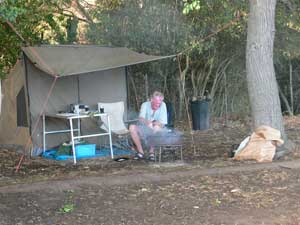


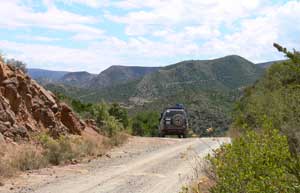

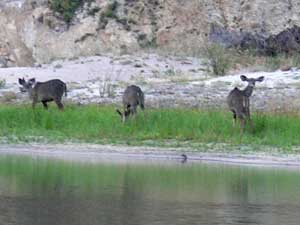
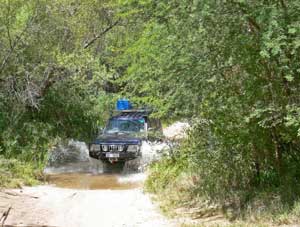
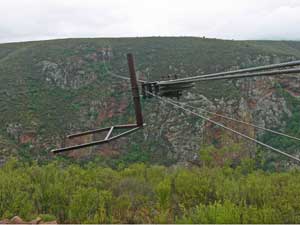
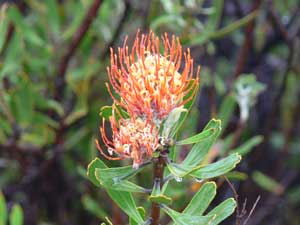
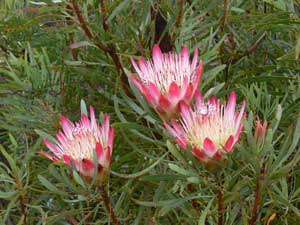
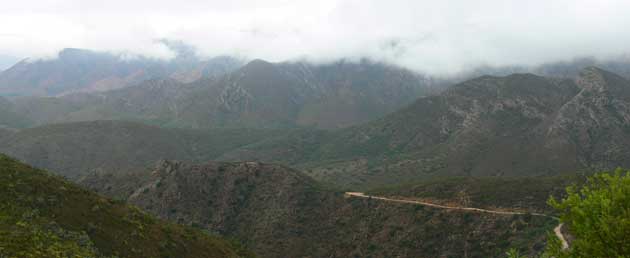

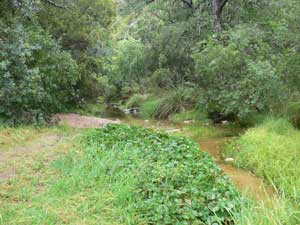
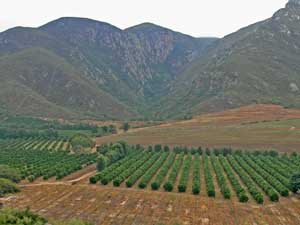
Rhodes
Mountain Zebra National Park
Graaff-Reinet
Baviaanskloof
Addo Elephant National Park
Hogsback
Diary - Word document